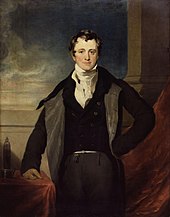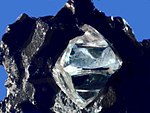User:HPLane/sandbox
Popular public figure
[edit]Davy revelled in his public status, as his lectures gathered many spectators. He became well known in 1799 due to his experiments with the physiological action of some gases, including laughing gas (nitrous oxide), with enthusiastic experimental subjects including his poet friends Robert Southey and Samuel Taylor Coleridge.[1]
Davy later damaged his eyesight in a laboratory accident with nitrogen trichloride.[2] Pierre Louis Dulong first prepared this compound in 1812, and lost two fingers and an eye in two separate explosions with it. Davy's own accident induced him to hire Michael Faraday as a co-worker, particularly for assistance with handwriting and record keeping [3].
European travels
[edit]

In 1812, Davy was knighted and gave up his lecturing position at the Royal Institution. He was given the title of Honorary Professor of Chemistry[4]. He gave a farewell lecture to the Institution, and married a wealthy widow, Jane Apreece. (While Davy was generally acknowledged as being faithful to his wife, their relationship was stormy, and in later years he travelled to continental Europe alone.)
Davy then published his Elements of Chemical Philosophy, part 1, volume 1, though other parts of this title were never completed. He made notes for a second edition, but it was never required[5]. In October 1813, he and his wife, accompanied by Michael Faraday as his scientific assistant (and valet), travelled to France to collect a medal that Napoleon Bonaparte had awarded Davy for his electro-chemical work. Faraday noted that 'Tis indeed a strange venture at this time, to trust ourselves in a foreign and hostile country, where so little regard is had to protestations of honour, that the slightest suspicion would be sufficient to seperate us for ever from England, and perhaps from life'[6]. Davy's party sailed from Plymouth to Morlaix by cartel, where they were searched[7].
Upon reaching Paris, Davy was a guest of honour at a meeting of the First Class of the Institut de France and met with André-Marie Ampère and other French chemists[8].
While in Paris, Davy attended lectures at the Ecole Polytechnique, including those by Joseph Louis Gay-Lussac on a mysterious substance isolated by Bernard Courtois. Davy wrote a paper for the Royal Society on the element, which is now called iodine.[9][10]. This led to a dispute between Davy and Gay-Lussac on who had the priority on the research[11].
Davy's party did not meet Napoleon in person, but they did visit the Empress Joséphine de Beauharnais at the Château de Malmaison[12]. The party left Paris in December 1813, travelling south to Italy.[13] They sojourned in Florence, where using the burning glass of the Grand Duke of Tuscany [14] in a series of experiments conducted with Faraday's assistance, Davy succeeded in using the sun's rays to ignite diamond, proving it is composed of pure carbon.
Davy's party continued to Rome, where he undertook experiments on iodine and chlorine and on the colours used in ancient paintings. This was the first chemical research on the pigments used by artists[15].
He also visited Naples and Mount Vesuvius, where he collected samples of crystals. By June 1814, they were in Milan, where they met Alessandro Volta, and then continued north to Geneva. They returned to Italy via Munich and Innsbruck, and when their plans to travel to Greece and Istanbul were abandoned after Napoleon's escape from Elba, they returned to England.
After the Battle of Waterloo, Davy wrote to Lord Liverpool urging that the French be treated with severity [16].
| “ | My Lord, I need not say to Your Lordship that the capitulation of Paris not a treaty; lest everything belonging to the future state of that capital & of France is open to discussion & that France is a conquered country. It is the duty of the allies to give her more restricted boundaries which shall not encroach upon the natural limits of other nations. to weaken her on the side of Italy, Germany & Flanders. To take back from her by contributions the wealth she has acquired by them to suffer her to retain nothing that the republican or imperial armies have stolen: This last duty is demanded no less by policy than justice. | ” |
— Sir Humphry Davy, in a letter to Lord LiverpoolCite error: A <ref> tag is missing the closing </ref> (see the help page).
| ||
- ^ Jay, Mike (8 August 2014). ""O, Excellent Air Bag": Humphry Davy and Nitrous Oxide". The Public Domain Review. 4 (16). Open Knowledge Foundation.

- ^ Humphry, Davy (1813). "On a New Detonating Compound". Philosophical Transactions of the Royal Society. 103: 1–7. doi:10.1098/rstl.1813.0002. JSTOR 107383.
- ^ * Knight, David (1992). Humphry Davy: Science and Power. Cambridge, UK: Cambridge University Press. ISBN 0-631-16816-8.
- ^ * Knight, David (1992). Humphry Davy: Science and Power. Cambridge, UK: Cambridge University Press. ISBN 0-631-16816-8.
- ^ * Knight, David (1992). Humphry Davy: Science and Power. Cambridge, UK: Cambridge University Press. ISBN 0-631-16816-8.
- ^ Jones, H.B. (1870). The life and letters of Faraday, Vol. 1. p. 75.
- ^ * Knight, David (1992). Humphry Davy: Science and Power. Cambridge, UK: Cambridge University Press. ISBN 0-631-16816-8.
- ^ * Knight, David (1992). Humphry Davy: Science and Power. Cambridge, UK: Cambridge University Press. ISBN 0-631-16816-8.
- ^ Davy, H. (1813). "Sur la nouvelle substance découverte par M. Courtois, dans le sel de Vareck". Annales de chimie. 88: 322.
- ^ Davy, Humphry (1 January 1814). "Some Experiments and Observations on a New Substance Which Becomes a Violet Coloured Gas by Heat". Phil. Trans. R. Soc. Lond. 104 (0): 74. doi:10.1098/rstl.1814.0007.
- ^ * Knight, David (1992). Humphry Davy: Science and Power. Cambridge, UK: Cambridge University Press. ISBN 0-631-16816-8.
- ^ * Knight, David (1992). Humphry Davy: Science and Power. Cambridge, UK: Cambridge University Press. ISBN 0-631-16816-8.
- ^ For information on the continental tour of Davy and Faraday, see Williams, L. Pearce (1965). Michael Faraday: A Biography. New York: Basic Books. p. 36. ISBN 0-306-80299-6.
- ^ * Faraday, Michael (1991). Bowers, Brian; Symons, Lenore (eds.). Curiosity Perfectly Satisfyed: Faraday's Travels in Europe, 1813-1815. London, UK: Peregrinus. ISBN 9780863412349.
- ^ * Knight, David (1992). Humphry Davy: Science and Power. Cambridge, UK: Cambridge University Press. ISBN 0-631-16816-8.
- ^ * Knight, David (1992). Humphry Davy: Science and Power. Cambridge, UK: Cambridge University Press. ISBN 0-631-16816-8.

